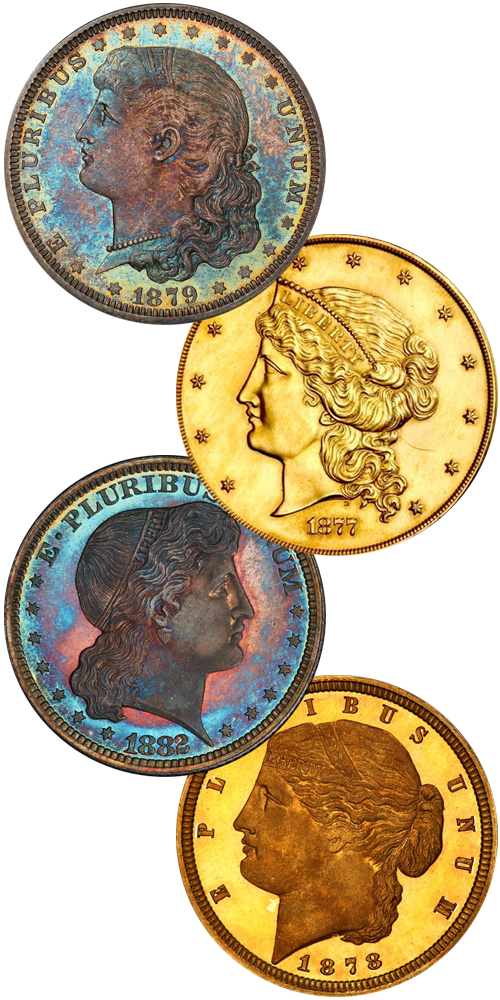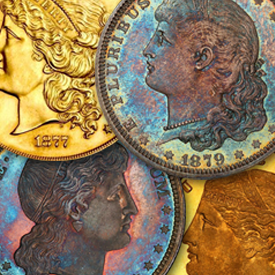“Open for me your cabinet of Patterns, and I open for you a record, which, but for these half-forgotten witnesses, would have disappeared under the finger of Time.”
Du Bois, Patterson. The Pattern Piece. Jan. 1883.
The field of U.S. pattern coinage is quite broad, and includes a variety of areas including die trials, hub trials, off-metal or experimental alloy strikes of both prospective and regular issues as well as proposed designs and denominations produced to see how they would look and feel “in the flesh” so to speak.
Patterns actually pre-date regular issue U.S. coinage; the Nova Constellatio patterns of 1783 and the proposed coinage designs by Robert Birch and other dating from 1792 being two such examples. Patterns can be broken into roughly three periods.
1. 1792-1835 – Very few patterns exist from this early period. Most were regular die trial pieces, some in off metals such as platinum, brass or white metal. All are either unique or known by only a tiny handful of examples – typically two to five pieces. Many of the pieces are either damaged, or were struck from heavily-rusted dies.
2. 1836-1885 – This era constitutes the vast bulk of the available population of patterns. Over 1,700 different patterns from this period have been identified, and included among them are such well-known issues as Gobrecht’s Seated Dollars of 1836-39, the 1849 Double Eagle, William Barber’s Amazonian Set of 1872, the $4 Stellas of 1879-1880 and the two $50 “Half Unions” of 1878 among others. In the late 1850s, interest in early U.S. coins boomed, and dozens if not hundreds of people began to collect coins. Some collectors with “connections” at the U.S. mint were able to procure various pattern pieces from mint officials and this certainly is the reason behind the relative availability of specimens during this period. Bear in mind however, that even a “common” pattern likely has fewer than 50 or at most 100 pieces known, so compared to regular issues, even the lowliest pattern is quite rare.
3. 1886-later – After several decades of abuse, Mint Officials cracked down on the “back door” distribution of patterns, severely curtailing the quantity of coins leaving the mint. While certainly some later patterns are in numismatic circulation – such as the 1896 Nickel, some of the 1907 gold issues (including the incredibly famous Indian Double Eagle by Saint-Gaudens), and several 1916 silver patterns, nearly all are extremely rare and quite costly today.
Several pattern issues, by virtue of the number of pieces struck, have “crossed the line” into the realm of regular issues, and are often collected as such. These include the Gobrecht Dollars of the late 1830s, the Flying Eagle Cents of 1856 and the 1879 Flowing Hair $4 gold piece or Stella. All of these coins saw mintages of at least several hundred pieces, and their inclusion in the Guidebook of United States Coins (the Redbook) has given them this “hybrid” status.
Some of the most interesting patterns are those identical to regular issue coins, but bearing an earlier date. Examples include an 1858 Indian Cent (J-208), an 1863 Two Cent piece (J-316), an 1882 “V” Nickel (J-1690) or the 1891 Barber dime, quarter and half (though these are all in the Smithsonian).
Because of their rarity, classifying and accounting for all the pattern issues has been a long and arduous task. The first attempt was by Robert Coulton Davis who issued the first lists in the Coin Collectors Journal between 1885 and 1887. This effort was followed by a monograph by Edgar H. Adams and William H. Woodin in 1913, which served as the basis for J. Hewitt Judd’s United States Pattern, Experimental and Trial Pieces in 1959. Published in at least seven editions through the early 1980s, this book served as the “bible” for pattern collectors for many years.
In recent years, several collaborators have revised and enhanced Judd’s original work. Among them are Abe Kosoff, Walter Breen, Q. David Bowers, Saul Teichman and Robert Hughes. In addition, an entirely new work by Andrew W. Pollock, United States Patterns and Related Issues was published by Stacks Bowers Galleries predecessor, Bowers and Merena Galleries in 1994.







